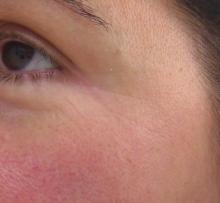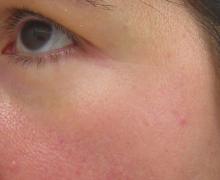DANA POINT, CALIF. – In the clinical experience of Dr. George J. Hruza, bipolar fractionated radiofrequency provides good wrinkle effacement, especially in the periorbital area.
"The benefits of bipolar fractionated radiofrequency include a limited downtime, no adverse events are seen, and any skin type can be treated," Dr. Hruza said at the Summit in Aesthetic Medicine sponsored by Skin Disease Education Foundation (SDEF).
Dr. Hruza, clinical professor of dermatology at St. Louis University, presented findings from a study of 22 adults with Fitzpatrick skin types I-IV who were treated with bipolar fractionated radiofrequency for visible wrinkles and/or elastosis. He and his associates used the Food and Drug Administration–cleared eMatrix radiofrequency device (Syneron) to treat two of the following facial regions per patient: the periorbital region, the perioral region, the cheeks, and the forehead.
Both 64 and 144 pin tips were used; energy was delivered at a range of 2-14 joules per pulse, or 20 J/double pulse, for a maximum duration of 50 milliseconds per pulse. Each patient underwent three treatments at 3 weeks apart. Topical anesthesia was used, and the patients were followed up a month after the last treatment.
Photographic analysis at the 1-month follow-up revealed that fine lines, smoothness, tightness, and brightness improved in about half of the patients by at least 40%. Periorbital photographic results demonstrated a mean improvement in fine lines of at least 30%, with almost all patients showing clinically significant improvement. A 6-month follow-up study of the patients showed persistence of the improvement.
Dr. Hruza noted that patients may experience micro peeling for 2-4 days after undergoing bipolar fractionated radiofrequency.
An emerging technology for deeper skin lesions is dermal bipolar fractionated radiofrequency, which delivers radiofrequency energy within the dermis via micro-needle electrode pairs. "Ninety-six percent of energy is absorbed in the dermis, and the thermal profile is confined along and between the needles," Dr. Hruza said. "This creates a controlled lesion and a fractionated zone of thermal injury."
Tumescent anesthesia is recommended for bipolar dermal fractionated radiofrequency, he said, because it protects deeper skin structures and reduces bleeding. The procedure typically requires 100-300 insertions in the lower face and upper neck. The needle entry points typically close in 2 hours.
Dr. Hruza said that he had no relevant disclosures.
SDEF and this news organization are owned by Elsevier.



